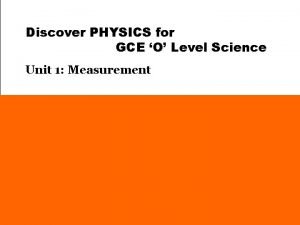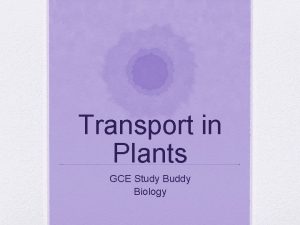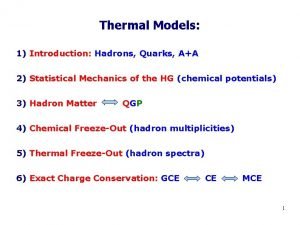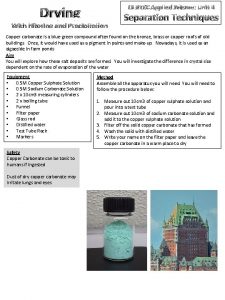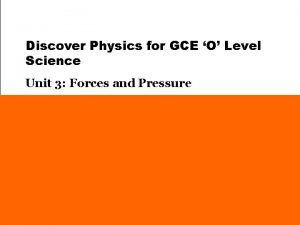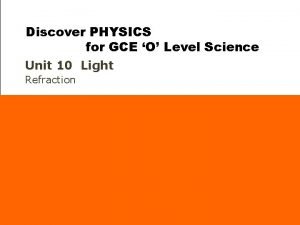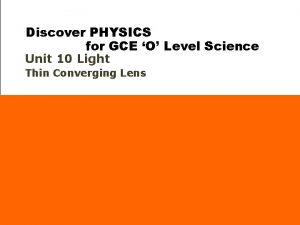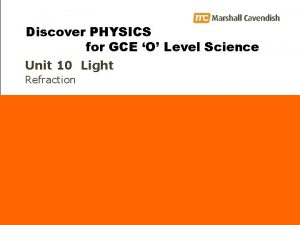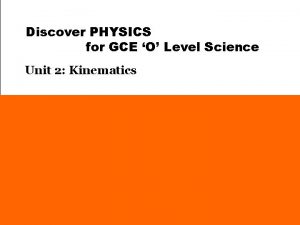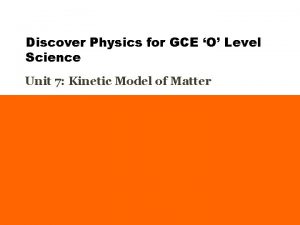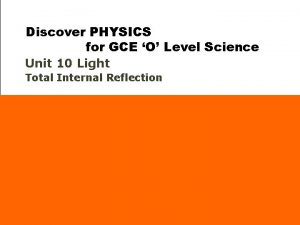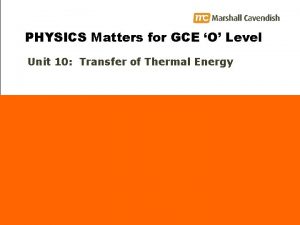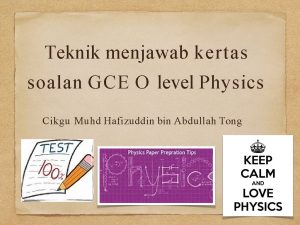Discover PHYSICS for GCE O Level Science Unit

































- Slides: 33

Discover PHYSICS for GCE ‘O’ Level Science Unit 4: Mass, Weight and Density

Unit 4. 1 Mass and Weight Learning Outcomes In this section, you’ll be able to: • define mass, gravitational field and gravitational field strength g • differentiate between mass and weight • recall and apply weight W = m x g to solve problems

Unit 4. 1: Mass and Weight What is mass? • Mass is a measure of the amount of matter or substance in a body. • The SI unit of mass is the kilogram (kg) Fig 4. 1 The number and composition of atoms and molecules make up the mass of a body.

Unit 4. 1: Mass and Weight What is weight? • Weight is a force and has direction pointing towards the centre of the earth (downwards). • Its SI unit is the Newton (N). • This force is called gravitational force or gravity.

Unit 4. 1: Mass and Weight What is gravitational field? • The Earth’s gravity is experienced by any object near it. • The region surrounding the Earth where gravity is experienced is called the gravitational field. • The force experienced is strongest on the surface of the earth and gets weaker further away. Fig 4. 3 Earth is surrounded by a gravitational field. Field lines are drawn to represent the gravitation field.

Unit 4. 1: Mass and Weight What is gravitational field strength? • Gravitational field strength g is defined as the gravitational force acting per unit mass on an object. • On Earth, the gravitational field strength is about 10 N kg-1 • A mass of 1 kg will weigh 10 N on Earth. • On Moon, the gravitational field strength is about 1. 6 N kg-1 • A mass of 1 kg will weigh 1. 6 N on Moon.

Unit 4. 1: Mass and Weight • The Moon’s gravitational pull causes high and low tides of the Earth’s ocean.

Unit 4. 1: Mass and Weight How are mass and weight related? • The weight or amount of gravitational force acting on an object is dependent on its mass. • The weight W can be found by W = mg where m = mass of object (in kg) g = gravitational field strength in (N kg-1)

Unit 4. 1: Mass and Weight How are mass and weight related? • Common weighing instruments such as electronic balance, spring balance and bathroom scales actually measure the weight and not the mass of an object. • Using the scale on Moon will give different readings. Fig 4. 7 The fastest way to lose weight.

Unit 4. 1: Mass and Weight How is mass measured? • Mass of an object does not depend on the gravitational field strength. • It can be measured using the beam balance. • The beam balance compares the gravitational force acting on an object with standard masses. (Unit 5)

Unit 4. 1: Mass and Weight Differences between mass and weight Table 4. 1 Differences between mass and weight.

Unit 4. 1 Mass and Weight

Unit 4. 1 Mass and Weight

Unit 4. 1 Mass and Weight Key Ideas 1. Mass measures the amount of matter or substance in a body. The SI unit is kilograms (kg) 2. Weight is the gravitational force acting on a body. The SI unit is newtons (N). 3. The weight of a body is related to its mass by the equation: W = mg 4. Gravitational field strength, in N kg-1 is the same as the acceleration of free fall in m s-2. 5. The weight of an object varies according to the gravitational field strength. The mass of an object is a physical property of the object that does not change.

Unit 4. 1: Mass and Weight Test Yourself 4. 1 1. List four differences between mass and weight.

Unit 4. 1 Mass and Weight Test Yourself 4. 1 2. Why is the mass of a body not affected by changes in the physical environment such as location? Answer: Mass is the amount of matter in the object. It does not change with physical environment.

Unit 4. 1: Mass and Weight Test Yourself 4. 1 3. We have learnt that Earth’s gravitational field strength g (10 N kg-1) is the same as its acceleration due to free fall, ag (10 m s-2). Even though their unit are different, N kg-1 vs m s-2, they are said to be dimensionally the same. Prove that N kg-1 is the same as m s-2. Answer: By the definition of newton N, it can be written as: N = kg m s-2 Hence N kg-1 = (kg m s-2) x kg-1 = m s-2 (shown)

Unit 4. 1: Mass and Weight Test Yourself 4. 1 4. The gravitational field strength of Jupiter is 22. 9 N kg-1. An astronaut weighs 1200 N on Earth. What will his weight on Jupiter be? Answer: First, we deduce the mass of the astronaut. Wearth = m gearth 1200 = m x 10 m = 1200 / 10 = 120 kg Hence his weight on Jupiter (if he managed to reach Jupiter) is WJupiter = m gjupiter = 120 x 22. 9 = 2750 N

Unit 4. 1: Mass and Weight Test Yourself 4. 1 5. What is the difference between gravitational field strength and gravitational pull? Answer: Gravitation field strength g is the gravitational force acting per unit mass on an object. g has SI units N kg-1. Gravitational pull is the gravitational force acting on the object and this is equivalent to its weight. The weight is given by W = mg Weight has SI units of N.

Unit 4. 2: Inertia Lesson Outcomes In this section, you’ll be able to: • understand define inertia.

Unit 4. 2: Inertia What is inertia? • Inertia of an object refers to the reluctance of the object to change its state of motion. • The inertia of an object depends on its mass. An object with more mass has greater inertia. Fig. 4. 13 Driver not wearing the seat belt. Fig. 4. 14 Driver wearing the seat belt.

Unit 4. 3 Density Lesson Outcomes In this section, you’ll be able to: • recall and apply density = mass/volume to solve problems

Unit 4. 3: Density • Density of a substance is defined as its mass per unit volume m = V where = density (in kg m-3) m = mass of object (in kg) V = volume of object (in m 3) The SI unit of density is kilogram per cubic metre (kg m-3)

Unit 4. 3: Density Table. 4. 2 Densities of common substances.

Unit 4. 3 Density Floating • Substances that float on water have lower densities than water. eg. Ice ( ice = 917 kg m-3) has a lower density than water ( water = 1000 kg m-3). Hence we can observe that ice floats on water. Do you know what would happen if we place the ice in turpentine? Fig 4. 16

Unit 4. 3: Density

Unit 4. 3: Density

Unit 4. 3: Density

Unit 4. 3: Density

Unit 4. 3 Density Key Ideas 1. The density of a substance is defined as its mass per unit volume. 2. The SI units for density is kg m-3. 3. The density of a substance is a fixed physical property. 4. Substances that are less dense than water will float on water. 5. To measure density of a substance, we measure its: a) Mass, eg. With a beam balance, and b) Volume, eg. Using mathematical formulae of volume (for regular objects) or measuring the volume of water it displaces (for irregular objects).

Unit 4. 2, 4. 3: Inertia & Density Test Yourself 4. 2 -4. 3 1. Two groups of people get into two identical cars. One group consists of five Sumo wrestlers while the other group consists of five marathon runners. Assuming both drivers step on the accelerator with equal force, state and explain a) which car takes off faster from rest, and b) which car will need a longer braking distance, once in motion. Answer: (a) The car with marathon runners has smaller mass. It is said to have smaller inertia. Hence it will take off faster. We can also see that by Newton’s 2 nd Law, a = F/m Hence the car with smaller mass will have a larger acceleration. (b) The car with the Sumo wrestlers will have a larger breaking distance since they have a larger inertia and hence greater reluctance to come to a stop.

Unit 4. 3: Density Test Yourself 4. 3 3. The density of water is 1000 kg m-3. What is the mass of 1 cm 3 of water in grams? Answer: Density of water Hence 1 cm 3 of water has a mass of 1 g.

Unit 4: Mass, Weight and Density
 Seven basic si units
Seven basic si units Ccea gce physics past papers
Ccea gce physics past papers How to answer what is your favorite subject
How to answer what is your favorite subject Gce buddy
Gce buddy Ocr chemistry b
Ocr chemistry b Cashflow1
Cashflow1 Gce professional business services
Gce professional business services Ccea gce chemistry practical support
Ccea gce chemistry practical support Ccea clarification of terms
Ccea clarification of terms Ccea a level business studies
Ccea a level business studies Gce.cummins
Gce.cummins English literature wjec
English literature wjec Ccea gce health and social care
Ccea gce health and social care English literature wjec a level
English literature wjec a level Qgp
Qgp Gymnasium christian-ernestinum
Gymnasium christian-ernestinum Unit 7 btec applied science
Unit 7 btec applied science Btec level 3 applied science unit 4 assignment b
Btec level 3 applied science unit 4 assignment b Unit 6 review questions
Unit 6 review questions Why does it happen
Why does it happen University physics with modern physics fifteenth edition
University physics with modern physics fifteenth edition Ib physics doc
Ib physics doc Iso 22301 utbildning
Iso 22301 utbildning Novell typiska drag
Novell typiska drag Tack för att ni lyssnade bild
Tack för att ni lyssnade bild Ekologiskt fotavtryck
Ekologiskt fotavtryck Shingelfrisyren
Shingelfrisyren En lathund för arbete med kontinuitetshantering
En lathund för arbete med kontinuitetshantering Kassaregister ideell förening
Kassaregister ideell förening Tidbok yrkesförare
Tidbok yrkesförare Sura för anatom
Sura för anatom Vad är densitet
Vad är densitet Datorkunskap för nybörjare
Datorkunskap för nybörjare Stig kerman
Stig kerman
